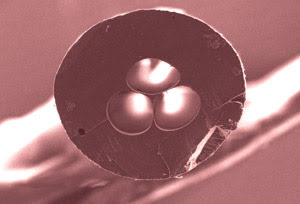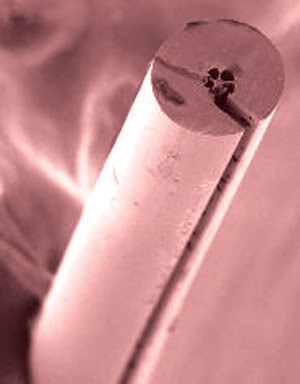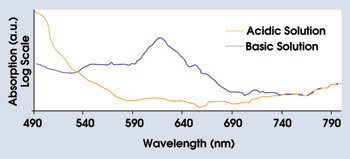A microstructured fiber enables access to the core for sensing and other applications.
Felicity M. Cox, Maryanne C.J. Large and Richard Lwin, University of Sydney, and Cristiano M.B. Cordeiro, State University of Campinas
Access to the core of an optical fiber is required for many applications, including evanescent wave sensing. Direct access to the core of conventional optical fibers has been achieved typically by removing the fiber cladding by etching or by tapering anywhere along the fiber. These processes leave the device fragile and, thus, limited in length because of the fragility.

Figure 1. A polymer microstructured optical fiber is a robust alternative to the etching or tapering processes.
A robust alternative is the microstructured optical fiber (Figure 1). These fibers are like drinking straws, with holes running along the length of the fiber forming the cladding, through which liquid or gas can be sucked up. Because the fiber jacket and cladding remain intact, the microstructured fibers suffer no limitations resulting from weakness. However, because the liquid enters at the bottom and exits at the top, applications that require direct access to the core along the fiber length, such as in distributed sensing schemes or in metal evaporation onto the core of the fiber, are ruled out.
The drawbacks of short device length, fragility and suboptimal access can be overcome with a recently developed variation of a microstructured optical fiber: a microstructured polymer optical fiber with a lateral slot running along its length, allowing access to the core anywhere along the length of the fiber without compromising the strength of the device.
The fibers were simple to fabricate. The normal procedure for manufacturing polymer microstructured optical fibers involves drawing an 8-cm-diameter preform to a 0.8-cm intermediate preform and drawing this intermediate preform to a fiber with a diameter of approximately 150 μm. To achieve a slot in the final fiber, a lateral hole was machined into the side of the intermediate preform using a jobber drill and a bench press. During drawing, this hole stretches into a slot. As an example, a 1-mm-diameter hole drilled into the side of the 0.8-cm intermediate preform produced 5 to 6 m of 150-μm slotted microstructured polymer optical fiber with an approximately uniform diameter. Various slot widths and lengths are achievable by using a range of drill sizes and fabrication conditions (Figure 2). It also is possible to drill several intersecting holes in a line in the intermediate preform, which forms an extended slot when drawn to fiber. In this case, steady-state draw conditions are achievable.

Figure 2. A five-hole fiber design shows how the slot extends along the length of the fiber.
The slotted microstructured polymer optical fiber can be used for chemical sensing because no further modification of the fiber is required. Evanescent wave chemical sensing is based on the fact that part of the guided mode in an optical fiber can be made to interact with the species to be sensed. The analyte can be brought into contact with the evanescent field of the slotted microstructured polymer optical fiber by simply “dipping” the flexible fiber into the relevant solution.
Unlike etched or tapered evanescent wave fiber optic sensors, the slotted microstructured polymer optical fiber is robust, so the low power present in the evanescent field can be compensated by using a long interaction length.
To demonstrate the use of the slotted microstructured polymer optical fiber as a sensor, a simple test was conducted using the indicator bromothymol blue, which is blue in basic solutions and yellow in acidic solutions. A three-hole slotted fiber was dipped into a beaker containing a basic (blue) solution of aqueous NaOH with a pH of 11.3. When aqueous HCl was added to bring the pH to 2.9, the color changed to yellow. At all times, white light from a supercontinuum light source was passed through the fiber and the spectrum recorded by a USB spectrometer from Ocean Optics Inc. of Dunedin, Fla.
The absorption spectrum was recorded of both the basic and acidic solutions into which the fiber was placed. A reference spectrum of the fiber in pure water was subtracted from the absorption spectra (Figure 3).

Figure 3. Two spectrally distinct forms of bromothymol blue are shown, making evident the ability of slotted microstructured polymer optical fiber to detect changes in absorption wavelength.
The spectra recorded immediately after the acidic and basic solutions were added do not support the notion that there is dead time experienced before the solution moves into the slot. The two spectrally distinct forms of bromothymol blue show that slotted microstructured polymer optical fibers can detect changes in absorption wavelength.
Absorption spectroscopy is merely one form of sensing for which the slotted microstructured polymer optical fiber can be used. Because the fiber is not restricted to use with a particular light source or detector, other techniques such as fluorescence detection and polarization modulation can be employed. Additionally, making a robust distributed chemosensor is now realistic, because the slot can be made to extend along the entire length of the fiber, allowing chemical species to diffuse into and out of the evanescent wave-sensing region anywhere along its length.
Further work will see the design of new slotted fibers, as well as the use of existing designs for new applications such as gas sensing. We also would like to functionalize the solid-core slotted fibers that we have made by depositing thin films on the core for various applications including biosensing. The thin films are advantageous for sensing as well as for other applications that involve some special functionalization of the fiber. Putting a different material on the core of the fiber can change the way light is guided in the fiber — and, hence, change its optical properties. So the ability to introduce other materials such as thin films onto the fiber core means that we can tailor the optical properties of the fiber.
Meet the authors
Felicity M. Cox and Richard Lwin are PhD candidates, and Maryanne C.J. Large is a researcher, at the Optical Fibre Technology Centre at the University of Sydney in Australia; e-mail: [email protected]. Cristiano M.B. Cordeiro is a researcher at State University of Campinas in Brazil.